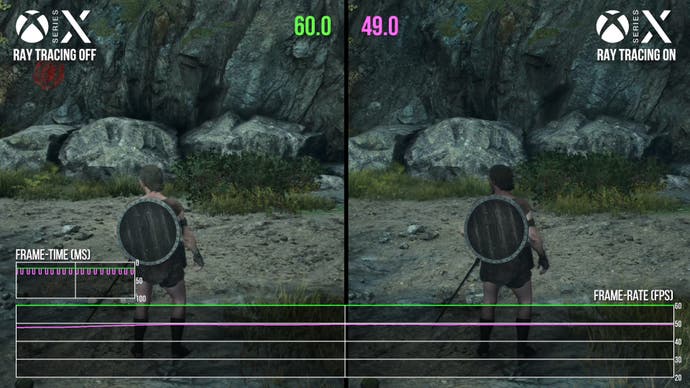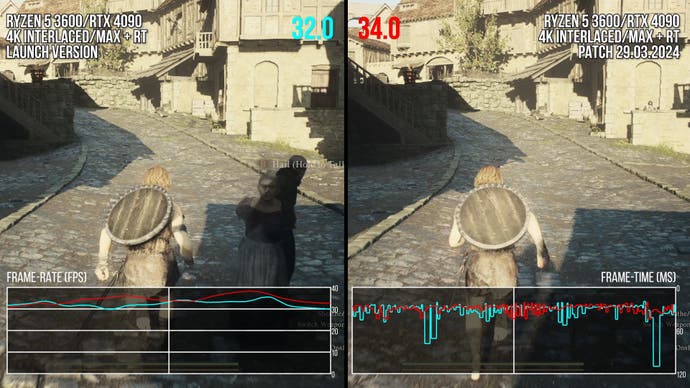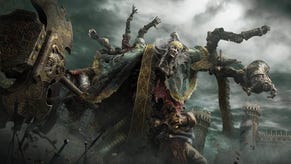Dragon's Dogma 2 patch analysis: more options are nice - but key issues remain
Toggling RT off boosts frame-rates - but the 30fps cap has frame-pacing problems.
Dragon's Dogma 2 is a technically advanced title that is often quite stunning, packing some of the best lighting I've seen this generation - while the gameplay mechanics have attracted multiple plaudits. However, on the flipside, there's no doubt that it's also saddled with performance issues and configuration problems, producing an occasionally unsatisfactory experience on both PC and console platforms. Thankfully, developer Capcom has been quick to deploy the game's first patch on consoles, which promises fixes for the game's variable frame-rate and always-on motion blur, alongside a toggle to disable its ray tracing effects entirely. Has the game been comprehensively improved? Or is this just one small step towards the more polished, performant game we would have liked to have seen at launch?
There are a surprising amount of changes in the first Dragon's Dogma 2 patch and one of the principle ways in which Capcom attempts to improve performance is to include the toggle to enable or disable ray traced global illumination - standard fare for other RE titles, but hard-set to the 'on' position when the game launched, with no RT support at all on Xbox Series S. Disable RT on Series X or PS5 though, and we get a markedly different lighting presentation.
To be fair, some shots look similar enough, but most of the time, the RTGI nicely fills in shade and adds bounce lighting that ends up being crucial to the way the image comes together, presenting a markedly more natural look whether indoors or outdoors, with much improved light occlusion. The new non-RT visual option gets screen-space ambient occlusion and some form of global illumination, it seems, but it's a far cry from how the game presents with ray tracing. Toggle RT on and off, and it's remarkable to see the limits of the more traditional SSAO laid bare.
So overall, while the option is welcome, the benefits of turning off RT are debatable. We're essentially getting the Series S feature set on Series X and PS5 and the results aren't flattering. But performance, expectedly, gets a substantial boost. On the Microsoft console, for example, a 49fps reading with RT enabled delivered a perfectly good 60fps with the feature turned off. Other scenes showed a 7fps to 10fps improvement. The ray tracing difference is most obvious in more naturalistic environments, when the system is more GPU-limited and calculating ray traced lighting is a bit of a struggle. However, in the game's city environments there's also a performance uplift, albeit a much smaller one. RTGI has a substantial CPU impact and I think we're seeing that difference here.
I do wish Capcom had gone further bearing in mind the performance limitations found in Dragon's Dogma 2 - a cut-back resolution target paired with toggling off RTGI might be enough to hit 60fps in the woods and other less dense environments, but as it stands, this seems like a decent option if you're willing to stomach the visual cutbacks, which are fairly obvious.
On the performance front, Capcom has also introduced an option to cap the game at 30fps and the results are variable and not quite what we'd hoped for. As expected, Dragon's Dogma 2 does indeed cap to 30 frames per second, but performance limitations remain - so the game can dip beneath under heavy load. However, frame-times are a bit of a mess owing to incorrect frame-pacing, with a mix of 16ms and 50ms frames sprinkled throughout - it should be a flat 33.3ms persistence per frame. It's frustrating as it renders this mode not especially useful, with no frame-time relief for those on conventionally-refreshed displays. If we take an excursion into the city, there are somewhat similar results, albeit with plenty of genuine frame-rate stumbles in the mix as well. Arguably, it feels slightly more stable here than the game running fully unlocked, but it's really not much of an improvement. I'd suggest that Capcom needs to go back to the drawing board on this one - properly frame-paced 30fps is essential if you're going to implement a cap.
Additionally, users also have the option to disable the game's motion blur. I actually quite like this game's implementation of motion blur, so this toggle isn't for me, but if you prefer a sharper presentation, that option is available. Dragon's Dogma 2 is an unstable game whether the 30fps cap is active or not and side-by-sides reveal that the motion blur does a fair bit to smooth out its otherwise inconsistent motion so I'd suggest keeping it on as well. However, as a quality of life addition for those with issues with the effect, it's obviously a worthwhile addition.
Finally, I wanted to close with a quick check-up on the game's default graphics configuration - with a variable frame-rate, motion blur, and ray tracing to see if there's any improvement more generally. However, visually speaking, it's the same experience we had before, as far as I can tell. The game looks identical in the shots I tested, aside from the time of day which can be challenging to match exactly. Unfortunately, that means the checkerboarding issue we discovered on Series X - with the game resolving a lot of checkerboard artifacts in the final resolve - is still present as of the latest patch. In performance terms it's close to an exact match, with little to differentiate it from the launch code. I don't think we've seen a substantial enhancement here, at least on Xbox Series X.
I took a look at PlayStation 5 too, naturally. Visually speaking, we're mostly in line with the Series console but weirdly, it seems like ambient occlusion isn't presenting properly when we turn ray tracing off. Compared to the Series X release, the PS5 looks relatively bereft of shadow, which produces some unsatisfying results. Sometimes the difference is mild, but at other times it can be quite stark. Ray tracing is still the preferred option, but even the Series X version without RT looks substantially better than the PS5 equivalent. However, on the flipside, Capcom's lack of a fix for the Series X checkerboarding bug sees PS5 resolving an overall cleaner presentation, with overall image quality far superior on Sony's console.


PS5 performance follows the same pattern as Series X. Frame-rates without ray tracing enabled continue to be noticeably higher than with the effect on, which is noticeable both in areas of heavy GPU and CPU stress. However, performance continues to lag behind Series X in GPU-bound shots, with the Microsoft console's wider GPU good for about an extra 10 percent in performance over the Sony machine. With RT on, performance relative to the previous patch is almost identical for the most part, clocking in with similar frame-rates in matching shots.
However, in our signature city run, there is a slight performance win, which I was able to replicate across a few runs. It's not really possible to get a perfect like-for-like run owing to dynamic elements in the city, but I suspect the PS5 version may be running ever so slightly faster as of the most recent update, though it's hard to be absolutely conclusive.
The motion blur toggle on PS5 functions about the same as on Series X and I'd recommend keeping it on, while the 30fps toggle has identical issues to its Xbox counterpart. Running unlocked with VRR active on a 120Hz display gives Xbox users an improved level of fluidity, but unfortunately, the PS5 system still doesn't support 120Hz with low frame-rate compensation, so there's no way to get the game to deliver a more consistent presentation on PS5 at the moment.


Finally, let's talk about the Xbox Series S. This shipped with no RT support at all, and the Series X/PS5 toggle doesn't make its way over to the junior Xbox. Performance versus the prior patch is a little inconsistent, actually showing lower results in some scenarios, but proving a near match for the prior version later on. It's generally about the same as before. However, I did notice that the same ambient occlusion difference observed between PS5 and Series X is also present when comparing the two Series machines.
Series X is operating with a better ambient occlusion setting in some circumstances with ray tracing off relative to the other two machines. A concession like that would make sense for the Series S, but would be more curious for the PS5, so perhaps that doesn't reflect the developer's intended behaviour. The rest comes in about as expected. The motion blur toggle is on Series S as well, and the 30fps cap is present but doesn't function with consistent frame-pacing - a real shame.
I'm not overly enthused about the S version overall as the lack of RTGI and much lower shadow resolution combine to make the lighting look a lot worse than the premium consoles. Given the hardware it might be tough to make up much ground there, but maybe Capcom should consider cutting back rendering resolution to improve shadows and perhaps add in higher quality ambient occlusion. The checkerboarding is broken here anyway, just like Series X, so targeting higher resolutions feels like a waste.


Finally, Alex Battaglia took a quick look at the PC version and found that it performed slightly better as of the most recent patch, with a seven percent improvement in CPU-bound performance over the course of this city run and a noticeably cleaner frame-time readout. Again, there are little performance deltas here and there that might suggest some small changes under the hood for this patch. I initially suspected that NPC draw distance might have been moved even closer but it's likely the same as before. It's hard to tell for sure because the game doesn't seem to have a fixed distance from the player where NPC draw occurs, so it's even possible to bump into invisible NPCs if you sprint through the city.
Dragon's Dogma 2 has improved with this first patch, but perhaps not in the ways many users might have hoped for. There are a range of visual toggles to help shape the experience, plus the addition of key quality of life changes like the ability to start a new game. However, key issues need to be resolved. The checkerboard reconstruction technique is fine on PlayStation 5, but clearly bugged on Series consoles - and so addressing this should be a priority. The 30 frame-rate cap needs a rethink, as solid 33.3ms frame-times are a must. Meanwhile, the ambient occlusion issues on PS5 and Series S need work.
Additionally, I'd like to see Capcom implement low frame-rate compensation when using VRR with 120Hz and I'm curious if an actual 60fps performance mode is possible - at least addressing the areas where the game is GPU-limited. And of course, by extension, I'd like to see genuine improvement when it comes to the game running CPU-limited. I think most players will probably be most interested in the last item, given how poorly Dragon's Dogma 2 runs in city environments, but I think all of these critiques should be resolved if possible.
That said, the entire situation is giving me an element of deja vu. There's a worrying trend with Capcom games arriving with odd, easily identifiable issues - as if a final parse of tech QA isn't happening. Last year's Resident Evil 4 was emblematic of this, launching with noticeable image quality and performance problems. Generally, these issues are minor, but on aggregate they create a less polished experience.
Dragon's Dogma 2 is much the same, launching with a slightly bizarre graphical configuration that seems designed to please very few console players. And right now, there isn't really a mode or version of the game that I can confidently recommend. The Series X with 120Hz output and VRR enabled would come closest, but you'd still have to contend with the poor checkerboarding in that case. Pile on the game's performance issues in densely-populated areas, which impact all platforms, and it hasn't been a perfect launch.
Still, this patch brings us closer to that ideal, especially if the 30fps cap can be sorted out. I hope this is the first in a succession of patches that will ultimately give us a truly polished version of this genuinely exciting, ambitious game.











